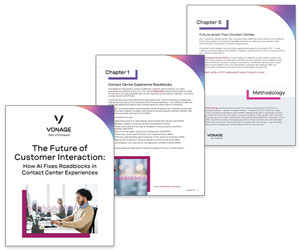Interactive Voice Response (IVR) systems are widely used in contact centres to streamline customer interactions.
They help route calls efficiently, reduce wait times, and even enable self-service options.
While many companies use IVR for basic call routing, there are several other ways this technology can enhance customer service and operational efficiency.
To find out more, we asked Tom Baker, Senior Product Manager at Vonage, to find out what IVRs are typically used for.
Video: Typical IVR Solutions
Watch the video below to hear Tom outline the typical uses of IVR solutions:
With thanks to Tom Baker, Senior Product Manager at Vonage, for contributing to this video.
4 Common Uses of IVR
These are some of the most common ways IVR systems are used to improve customer service and streamline operations:
1. Call Routing
The most typical application of IVR is directing callers to the appropriate department, with callers selecting from options that match their inquiry, ensuring they are connected to the right team.
“The first and most common use of an IVR is to direct callers to the right people within your business. So you’ll have a main telephone number that you offer to callers.
You will present them with a number of different options so that they can select what their inquiry is about. And depending on what they select, you can then direct them to the right people within your business.
For example, sales, service, warranty, retentions, finance, however your business is structured. Now there’s a whole bunch of other things that you can do with an IVR outside of that typical functionality.”
2. Call Deflection
Instead of speaking to an agent, customers can receive automated voice messages, text messages, or be directed to online resources for quick resolution.
“You can use an IVR for deflection to easier-to-serve methods.
So if you don’t want certain types of inquiry to be handled by people, you can direct them to audible messages that will tell the caller what they need to do instead.
You could send them text messages, you could direct them to relevant pieces of your website, or you could divert them to non-voice channels like text, chat, that kind of thing, which might be easier to serve.”
3. Self-Service Options
IVR can be set up to allow customers to make payments, check balances, or update account details without agent assistance, reducing workload for support teams.
“You can also build self-service systems in general, which could include payment systems, within your IVR.
This will allow the caller to take action without needing to speak to someone, which reduces your overall need for agents to answer typical inquiries.”
4. AI Integration for Conversational Support
Instead of menu-based options, AI-driven IVR can offer natural conversations, helping customers find solutions through voice recognition before transferring to a live agent when needed, as Tom explains:
“Then, depending on how complex you want to get, you can integrate the IVR with your back-end systems, and you could introduce some kind of AI solution.
And so instead of going from a press one, press two, press three, option-type system, you can instead have a much more conversational interaction with the IVR, where an AI solution says, ‘Hi, I am a voice bot, I can help you with X, Y, Z. Tell me what you need’.
And then you can converse with it, it will understand you, and then it will present options for how it can resolve the issues. And if it’s unable to, it can then hand off to a human being for more complex solutions.”
Enhancing IVR with Advanced Features
Contact centres looking to improve efficiency can integrate IVR with backend systems for personalised experiences.
For example, a customer calling from a registered number could be greeted by name and offered tailored options based on their account history.
By expanding IVR beyond simple call routing, contact centres can provide faster, more convenient support while reducing the demand on human agents.
If you are looking for more great insights from the experts, check out these next:
- The Difference Between WFM, WFO and WEM
- Understanding Sentiment Analysis
- WFM Tools That Are Available
- Understanding How IVR Works
Author: Robyn Coppell
Reviewed by: Hannah Swankie
Published On: 6th Sep 2022 - Last modified: 25th Sep 2025
Read more about - Video, Artificial Intelligence (AI), IVR Solutions, Tom Baker, Videos, Vonage



















